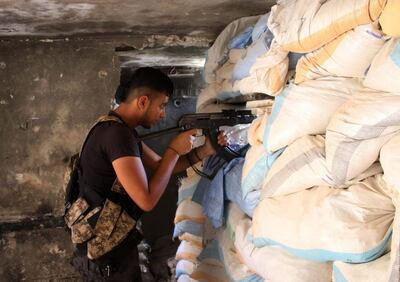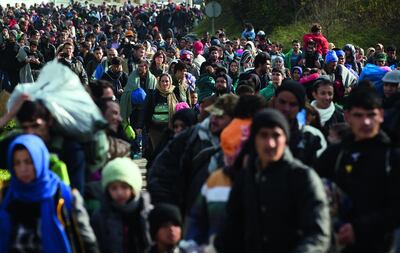In 2010, Ahmed Aljundy graduated as a teacher from the university in Deraa, the Syrian town where he grew up, and quickly worked out a deal with a cousin in Dubai to drive lorries between the UAE and Saudi Arabia.
When he returned to Syria in 2011, the country’s revolution, which would with startling speed evolve into a bloody and internecine civil war, was only three months old.
"It is like I entered into a different country. Everything was different, everything was changed and everything was out of control," he told The National.
Ahmed, 35, now lives in Plymouth in the south of England with his wife and their three sons after smuggling himself across Europe.
They were granted refugee status in 2014, just one year before Europe’s migration crisis worked itself into its febrile 2015 crescendo that left the continent itself utterly changed.
In 2010, a total of 259,400 people made their first application for asylum in the European Union, according to Eurostat, the EU’s statistics office. That number had more than doubled to 626,960 by 2014, driven by the surge in migration across the central Mediterranean, principally from Libya to Italy.
In 2015, the number more than doubled again to 1,322,825 as predominantly Syrian refugees crossed by sea from Turkey to Greece.
Ahmed’s journey along that route, after he left Deraa in December 2013, prefigured the journey hundreds of thousands of migrants and refugees would take in the following years.
He paid smugglers €2,500 (Dh10,300) to take him across the Aegean to Greece in a crowded fishing boat with 105 other people. Later he would lose a cousin when a second boat they travelled in capsized on a less common migration route across the Adriatic to Italy.
The decision to leave Syria and the price that was paid for his family's safety is one Ahmed reflects on with mixed emotions. "There is no place like home," he said, but explained the decision to leave had been a necessary one. "To be honest it was not a hard time to leave my country. If it had been safe and everything was OK, it would have been difficult," he said. Many others went on to make the same calculation.

Frontex, the EU's border agency, said just 55,000 people attempted to cross into Europe on the so-called Eastern European route in 2010. That number actually fell in 2013 to 37,200 and then rose to a similar level of 50,830 in 2014.
In 2015, 885,386 illegal border crossings were recorded on the route. This direction of travel saw hundreds of thousands of migrants attempting to reach Greece’s eastern Aegean Islands from Turkey, often in unseaworthy rubber dinghies.
The crossing was deadly. According to the International Organisation for Migration, as many as 3,072 people died or disappeared in the Mediterranean in 2014 while trying to reach Europe. As well as those crossing from Greece to Turkey, these numbers include the more dangerous route from Libya to Italy and other southern European nations.
In 2015, the IOM estimated that about 3,692 migrants and refugees lost their lives in the Mediterranean. A total of 2,889 were killed in the Central Mediterranean compared to 731 in the Aegean.
Aloys Vimard, a project coordinator for the medical NGO, Medecins Sans Frontieres, was part of the scrambled response to the 2015 crisis. Working on Samos island in the Aegean, Mr Vimard's job was to bolster local organisations in whichever way he could.
“At that time it was around 1,000 arriving every day in Samos island,” he said. “It was completely crazy. I worked super, super hard day and night because people were arriving in big, big numbers and we were the only NGO working there.”
Now, as the focus of Europe’s migrant crisis has shifted away from the eastern Mediterranean back to the central route from North Africa, so too has Mr Vimard’s work.
Since 2018 he has co-ordinated rescues on board the Ocean Viking, an MSF search and rescue vessel. He spoke to The National over the phone from the search and rescue area four days out of the southern French port of Marseilles.

"Every time I hear about a boat in distress I have to pinch myself to believe it. It is so risky. They are in these unseaworthy dinghies and it is hard to believe that people are seeking safety by taking so much risk really," he said.
Mr Vimard witnessed first-hand as European governments and the European Union enforced a policy of containment towards migrants over the last two years.
In March 2016 the EU agreed on a deal with Turkey to stem the influx of refugees and migrants on the eastern Mediterranean route.
The agreement, which made provisions for the deportation of unsuccessful asylum claimants back to Turkey, was effective in reducing the number of migrants and refugees attempting to reach Europe.
The number of migrants attempting to cross the Aegean illegally in 2016 fell considerably to 182,277, Frontex said. In 2018, the Eastern Mediterranean route registered 56,561 illegal border-crossings.
In February 2017, Italy struck a deal with its former colony Libya in a similar effort stop migrants arriving on its shores. The deal, which essentially led to the warehousing of migrants in Libya and was condemned as "inhuman" by the UN, was renewed automatically in November this year.
As in Greece, the deal with Libya has caused crossings to fall. In 2016, 181,376 migrants were detected on the Central Mediterranean route, the highest number ever recorded, according to Frontex.
In 2018, the Central Mediterranean route experienced the biggest drop in the number of irregular migrants. The total number of irregular border crossings plunged 80 per cent to 23 485, the lowest number since 2012.

Mr Vimard says the effect of Europe and Italy’s containment in the Central Mediterranean has been “really disturbing”. The handing over of operations to the Libyan coastguard has left MSF essentially blind as it carries out its rescue missions and the criminalisation of migrant vessels operating in Italian waters in 2018 was deeply disruptive to the rescues.
Perhaps worst of all, he said, is the desperation of the migrants and refugees coming from war-torn Libya.
“As the conflict in Libya has intensified in 2019 we can see the situation has changed. The situation was horrific for migrants, refugees and asylum seekers in Libya and now the ones that are taken to the detention centres are very near the front lines,” the MSF co-ordinator said.
"More and more people being intercepted at sea, attempting several times to cross. So what we have seen for sure is that the number has reduced … but the number of people with the chance to die at sea is constantly rising."
The migrant crisis has profoundly changed Europe's own politics. In virtually every country the far right has made gains unthinkable in 2010, largely on the back of the migrant crisis.
For Inma Vazquez, MSF’s representative to the EU, the rise of the far right in Europe has led to paralysis in Brussels over migration policy and made the continent even less prepared to deal with another large influx of migrants, were it to ever face the same challenges as it did in 2015.

“We find officials, technical people, those in management that they express the wish to do better but then there is this systematic barrier,” she said.
“They say if we do more, we will have the far right come in at the elections and so on. That's the discourse that I hear constantly in all the meetings.
“I don't think this is a controversial opinion. I don't think it will just be as bad as before,” Ms Vazquez said referring to the possibility of another influx of migrants.
“I think it would be worse. The tolerance of the people, as we can see from the elections, we can see that the tolerance is less.”
Away from the overarching legacy left by Europe’s migrant crisis this decade, those who have made their homes on the continent have, at least, survived and must reconcile themselves with their past.
Ahmed in Plymouth still thinks with longing of his home in Syria and worries about his family who have struggled through losses – his mother-in-law, his two brothers-in-law, their children and their wives were killed in government air strikes in 2014.
“You don't know when this bomb will come to you. I was lucky because now I am alive. But there are many, many people who we know and don't know who are now not alive,” he said.
His integration into the community has been hard-won. He has had to work half a dozen difficult and poorly paid jobs in the last five years but now is happy working as an upholsterer for a company that furnishes luxury yachts. He is most hopeful for his eldest child Rayan, who is five and a half years old.
“He is better than me at English,” Ahmed said laughing. “He's in year one at school now and he really loves it,” he went on. “I think my children have a better life.”







